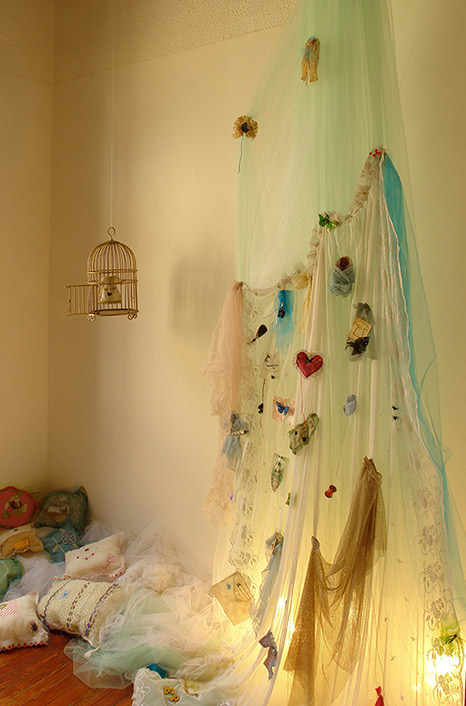MANIFIESTO
MANIFEST
Y retomé el arte textil.
Recuperé mi memoria de juventud, de aquel tiempo cuando realizaba tapices con mi abuela. Yo dibujaba y pintaba los bocetos, ambas bordábamos y cosíamos sobre arpillera.
Privilegié los medios simples, porque son los que mejor traducen mis intenciones de acercarme a la gente.
Las obras de los artistas tienen que ser inteligibles.
Sin renunciar a la creación personal sentí el arte como posibilidad colectiva.
Y entonces se me ocurrió proponer la Tela participativa, todos cosiendo, sin distinción de sexos. Metáfora que de ninguna manera pretende un retorno de la mujer a sus labores, a aquellas tareas impuestas por la sociedad patriarcal.
La ofrecí al público para intervenir cosiendo y bordando, incorporando en ella todo tipo de elementos: telas, plumas, peines, lanas, espejos, cabellos, papel…
Rechacé el consumo material desenfrenado.
Aspiré a volver a la sobriedad y a la mesura.
Propuse un regreso a lo sencillo y a lo natural.
Valoré la sacralidad de la Naturaleza y del Hombre por pertenecer a ella.
Mi deseo consistió en que ambos sexos tomen conciencia de la situación límite en la que se encuentra nuestro mundo.
Esto podría salvarnos.
Quise extenderme y abarcar el mundo. La tela llegó a tener 30 mts. de largo, y recorrió muchos lugares.
Un espacio cosido es un espacio vivo, porque la aguja, se utiliza para reparar el daño.
¿Será que el mundo está intentando su sanación?
A SEWN-FABRIC MANIFESTO by Estela Pereda
And I returned to textile art. I recovered the memory of my youth, when I would make tapestries with my grandmother. I would draw and paint the patterns, and together we would embroider and sew on burlap. I privileged simple media, because they are the ones that best translate my intention to bring people together. Artists’ works must be intelligible. Without eschewing personal creation, art is, I feel, a collective possibility. And so I came up with the idea of a participative fabric where everyone would sew, with no distinction between the sexes. A metaphor that in no way attempts to return woman to her domestic tasks, the ones imposed on her by patriarchal society. I made that fabric available to the public to sew and embroider on, incorporating all sorts of elements: pieces of fabric and wool, feathers, combs, mirrors, hair, paper… I rejected unbridled consumerism. I tried to restore a sense of sobriety and moderation. I proposed a return to simplicity and nature. I cherished the sacredness of Nature and of Man as part of it. It was my wish that both sexes become aware of the dangerous situation our world is in. That could save us. I wanted to expand and encompass the world. The canvas had grown—it was thirty meters long and traveled widely. A sewn space is a living space, because the needle is used to suture damage. Might the world be trying to heal itself?

Rincón para pensar
Instalación, medidas variables, Bienal de Arte Textil Galería Archimboldo, año 2011.